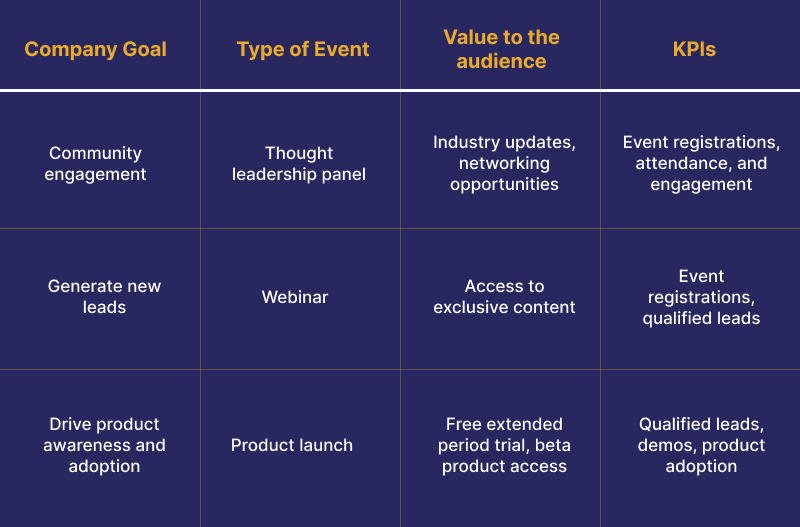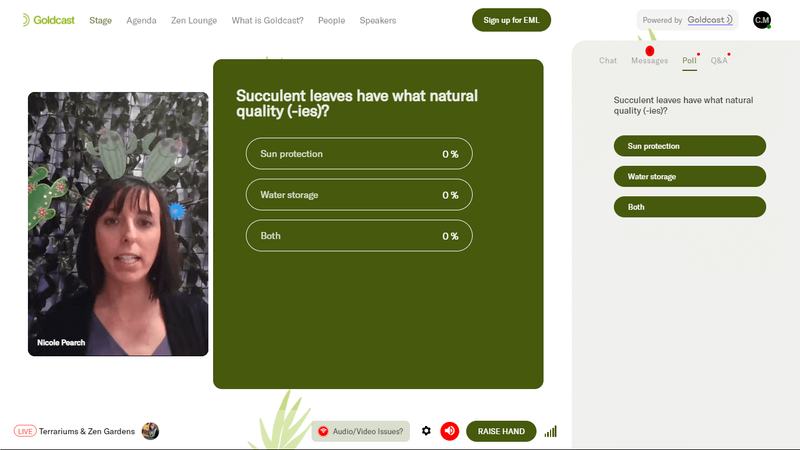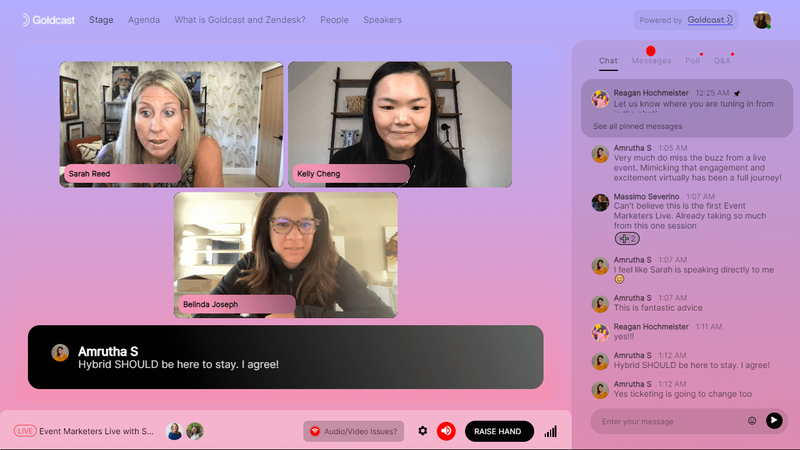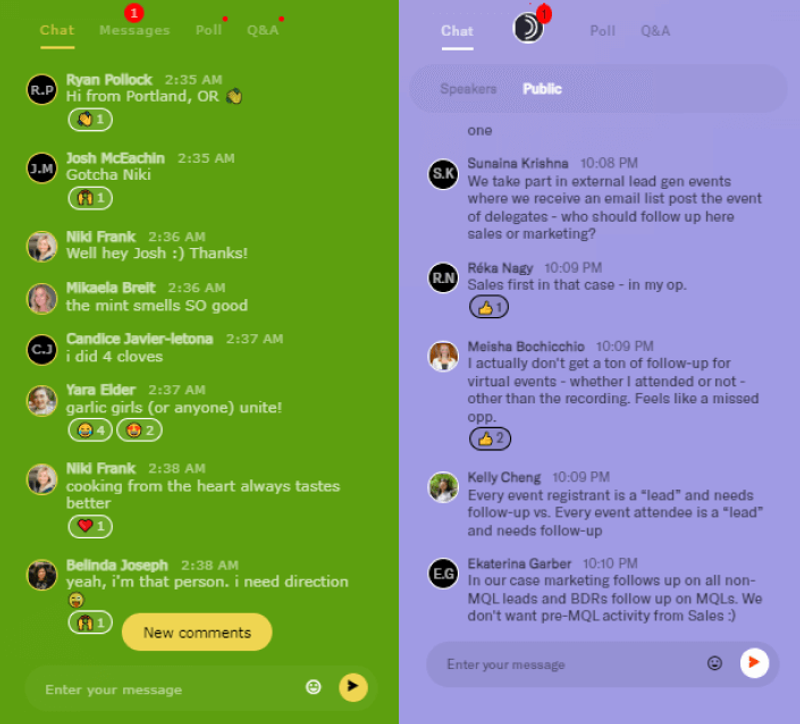B2B Events Simplified: A 15-Point Virtual Event Checklist

Table of Contents
Maximize Your Marketing ROI
Join 10,000 other marketers already getting the best tips on running engaging events that boost pipeline and create raving fans.
Virtual events have quickly become savvy marketers' secret weapon—and it’s not hard to see why! Virtual events check a lot of boxes.
- Reach a broad, diverse audience? Check! ✅
- Build and engage a community? Check! ✅
- Drive pipeline and revenue? Check, check! ✅ ✅
And while virtual events are often perceived as an “easy” replacement for in-person engagements, this isn’t necessarily the case. Even a “simple” webinar requires a lot of planning and preparation—but don’t panic.
We’ve compiled this handy virtual event checklist to help streamline your event planning. We fully recognize that every event is unique, so we recommend using this template as a starting point and refining it as needed for your event strategy. With that, let’s dive in!
Here’s what we’ll cover:
- What are virtual events?
- Before a virtual event
- During a virtual event
- After a virtual event
What are virtual events?
First things first, what’s a virtual event? Simply put, virtual events are events hosted remotely through the power of the internet.
Many event marketers had to pivot during COVID-19, and virtual events are more mainstream than ever before.
Whether it’s a simple webinar or a multi-day, multi-track conference, virtual events allow you to connect with your target audience from the comfort and convenience of their own home or wherever they’re based.
All you need to execute a virtual event is a working internet connection, a computer or a smartphone, a minimal tech setup, and an event technology platform, and you are set!
While virtual events were synonymous with webinars a few years back, their scope has grown so much lately that organizations now host full-fledged multi-day virtual conferences, summits, training programs, and trade shows.
💡Need some inspo? Check out these ten virtual event ideas for every stage of the funnel.
Checklist: Before your virtual event
The pre-event prep begins with the basics like setting event goals, identifying your target audience, choosing the best event format, and planning event promotions.
Here are a few things you’ll want to nail down before you go live:
1. Set your event goals
Every good project starts with a goal! For virtual events specifically, it helps to approach event goal setting from two different angles.
- The first angle is deciding what you want to achieve through the virtual event. Set SMART goals (Specific, Measurable, Achievable, Realistic, and Time-bound) to make goal tracking effective.
- The second angle is what you would like the attendees to take away from the event or the WIIFM (what’s in it for me?). The value for the audience is essential. Communicate this value early and often to build hype, and be sure to deliver on that promise during the actual event.
Here are a few examples of how both angles fit together and map to key performance indicators (KPIs):

2. Define your audience
You likely have multiple target buyer personas or audiences—and that’s ok. But not every segment would be relevant for a single event. So, pick only those personas that would benefit the most from your event.
Is your event an exclusive learning event just for current customers? What about a highly-targeted AMB-style event for VIP target accounts? Maybe there’s one specific persona you’re trying to boost engagement with?
Take time to think through your goal and what audience is most relevant.
3. Nail down your event concept
Next, you need to nail down your virtual event concept.
What’s the overarching theme? How many sessions will your event have? Will you incorporate networking and virtual engagement? What event format will work best for what you’re trying to accomplish?

Much of this will tie back to your goal. For example, a 45-minute interview-style event would be great for general thought leadership and community engagement. A multi-track conference-style event would be ideal for nurturing leads and driving pipeline.
Be sure to also think about the event branding. Remember, you want to WOW the audience with a polished and professional event.
4. Prepare the event brief
As the name suggests, an event brief is a simplified version of your full event plan. This master document should link out to all other relevant documents and serve as the “single source of truth” for anyone on the team looking for info on the event.
Here are a few things to include in your event brief: event timeline, resource planning, master project plan, promotional plans and materials, and the event budget.
👋 Pssst! Check out this free guide to nailing your event brief.
5. Select your event platform
For a virtual event that packs a punch, you’re going to want a platform that delivers.
Specifically, look for a solution that allows you to fully brand your event. You want an event that looks and feels like your brand—not the providers.
You’ll also want some creative levers to engage your audience directly. Think the basics, like live chat, Q&A, and polls, plus more innovative features, like video Q&A, gamification, and embedded apps for games, photo booths, and more. Embrace creative engagement levers and watch the time spent in your event skyrocket.

Finally, you’ll want an event platform that makes it super easy to attend. Things like single-click Magic Links, scheduled email reminders, and automatic calendar holds will keep your event top of mind and increase show rates.
The Zoom fatigue is real, and attendees are likely stuck in multiple Zoom-esque meetings each day. Surprise and delight your audience with a slick, polished event experience that will have them buzzing for days.
💻 New to virtual events? Peep this Platform Buyer’s Guide for handy tips when shopping for solutions.
6. Craft a content plan
Content is anindispensable part of a virtual event, no matter its size. It’s what drives the pre-event buzz, increases event engagement, and improves the overall attendee experience. You want attendees fully immersed in the session and eager to participate in polls, Q&A, etc.
The content plan should cover content leading up to the event, the event agenda and programming, and post-event engagement.
Let’s look at a few examples of how you can use content to drive your event:
- Ask event speakers to post a video on social media hyping their session and inviting their audience to attend.
- Use multiple content formats like video and audio clips, slides, live polls, etc., during individual sessions to keep attendees engaged
- Live tweet key event sessions, and use a dedicated event hashtag to invite folks to join the conversation.
- Thoughtful post-event emails segmented for folks that did and did not attend. You could even segment out target accounts or attendees that were particularly engaged for an even more personalized follow-up.
- Repurpose event sessions into blog posts or podcast episodes after the event.
Crafting event content also includes sourcing buzz-worthy speakers. Internal folks that are comfortable on camera are a great option for thought leadership and product topics. For external speakers, look for speakers at partner companies or within your space that share a similar audience.
And don’t forget about session content—the meat of your event. For smaller virtual events, like webinars, event content might be owned by someone on the content or demand generation team. For larger events, like conferences, event content is owned by a dedicated events team.
Don’t underestimate the time it takes to create event content. Start planning your content early, and work closely with design to make sure everything looks and feels sharp.
✍️ Events are a treasure trove of additional content. Learn how to use content before, during, and after your event.
7. Promote your event
You’ve set some event goals and nailed down your format—now it’s time for the fun part… promotion! Event promotion possibilities are only limited by your imagination (ok, and your budget, too).
Typically, how far in advance you promote your event is directly correlated to how large the event is. A webinar might only have a one to two-week promo period, while a flagship annual event might be promoted for several months.
Here are a few ideas on how to promote your event and drive registrations:
- Run targeted ads on social media platforms. Be sure to focus on the platforms where your audience spends the most time. For B2B folks, this is likely LinkedIn. Consider highly-targeted ads that use remarketing lists and lookalike audiences to get the best bang for your buck.
- Connect with newer audiences through industry newsletters. Scope out publications or communities that cater to your niche, and evaluate partnership opportunities to spread the word about your event.
- Create social media content for speakers they can share on their social media accounts. The easier you make it for folks to share, the more likely they will help spread the word.
- Host giveaway contests with sponsors to drive engagement. You can offer free event access, product subscriptions, or other freebies to up the ante.
- Create an exclusive community of attendees on Slack, Discord, and other social media platforms. Invite speakers to host weekly chats or ask me anything (AMA) sessions.
🌟 Planning a webinar or virtual event? Check out this five-step event promo guide to drive more registrations and attendees.
8. Schedule a dry run before the event
You’ll want to make sure all speakers and guests are super comfortable before the event.
Schedule dry run sessions with folks a few weeks in advance to be sure their tech setup works, their background is quiet and professional, and they fully understand how your virtual event platform works.
If your event has sponsors, you’ll also want to get all sponsor materials uploaded to the platform in advance and give sponsors a chance to review and make any necessary changes.

Checklist: During your virtual event
You’ve made it to the big day! The day of your event is likely filled with high-octane activities.
You’re on the hook to assist speakers and attendees, encourage everyone to engage during sessions, and be the point of contact for the entire event experience. No big, right?
Here’s a quick rundown of things to add to your to-do list during the event:
9. Engage your audience
As we mentioned earlier, Zoom fatigue is the curse of virtual events. It’s harder than ever to capture and keep attention. You’ll need an A+ engagement plan to keep folks active and interested during your sessions.
Here are a few ideas for engaging attendees during event sessions:
- Gamification: Marketers love gamification because novelty boosts the event experience. Whether a simple icebreaker or an elaborate Scavenger Hunt, event gamification works because it actively engages the participants.
- Polls and Q&A: Polls and Q&A during and after sessions offer tiny breaks that let attendees take a breather, turn off the attentive listening mode, and turn on the thinking mode to digest the information.
- Activities: Live performances, standup comedy, meditation sessions, happy hours, virtual cooking classes, and more allow attendees to mindfully engage with these activities while reducing the cognitive load. Get creative, and break up your event with fun, immersive activities.
10. Moderate breakout sessions
Breakout sessions are a great way to break up individual sessions and get folks together in smaller rooms. There are several creative ways to use both breakout sessions and networking rooms, so let’s break it down.
First things first, decide whether you want to allow folks to choose-their-own adventure (via Rooms) or if you want to randomize or pre-assign sessions (via Breakout Sessions). The main difference between the two is that folks can voluntarily enter Rooms versus Breakout Sessions, where they are added to groups by the event organizer.
Here’s a quick summary:
- Breakout rooms: Rooms function like mini zoom calls within the event platform, allowing small groups to chat in an intimate setting. Attendees can hop into and out of rooms as they please without losing track of the event.
- Breakout sessions: Manage pre-assigned or randomized breakout rooms, whichever suits your agenda. These sessions allow attendees to network and engage in a more structured setting.
💥Struggling for ideas? Check out this post on ten creative breakout session ideas for inspiration!
11. Create a live event support plan
Do not wait until the last minute to plan for event support. The last thing you want is to put out fires at the eleventh hour!
As noted above, event organizers are often on the hook for live event support. This might include moderating the live chat during sessions, assisting speakers with slides and videos, or providing technical support during the event.
Depending on the size of your event, it’s helpful to have a few folks on the team available to help with behind-the-scenes event support. People on sales, demand generation, content, and more should be fully equipped to help with these activities.
For larger events, having a platform partner that offers event support is a huge game-changer. Look for a provider where you have a dedicated point of contact and customer support to ensure your virtual event is flawless.

Checklist: After your virtual event
Whew! The event might be over, but the work is far from done. After the cameras turn off and attendees go about their day, the post-event work kicks into high gear.
Now, it’s time to send out post-event emails and recaps, analyze event data, engage sales for timely follow-ups, and start planning for the next event.
12. Analyze event analytics data
There’s nothing more powerful to a business than data. Robust analytics is another key feature you’ll want to look for in your virtual event provider.
Specifically, look for a platform that provides data beyond just event registrations and attendees. You’ll want to go deeper into individual attendee engagement on a per-session level and import all of that rich data into your other tools like marketing automation and CRM platforms. This will allow you to score leads based on their interest and engagement level.

On a broader level, check other platforms like Google Analytics, social media management tools, your CRM, etc., to analyze the effectiveness of your event marketing campaigns across various channels.
Be sure to map relevant KPIs back to the event goals that you set at the beginning of this process.
13. Send a post-event survey
You put a ton of time and energy into planning and executing stellar virtual events. While your internal team might be great cheerleaders, it’s important to get direct feedback from attendees and partners on their perceptions.
These event surveys can be as high-level or granular as you like. For a webinar, a short 5-question or less survey will likely cover your bases. For larger events, individual session surveys can be helpful in understanding the relevance and impact of specific topics and speakers.
Don’t forget specific surveys for partners or sponsors. You’ll definitely want to ensure a smooth and enjoyable experience to keep these folks happy.
Include these surveys in your post-event email, and consider a giveaway or another incentive to increase the submission rate.
Remember—feedback is a gift. As Bill Gates once said, “Your most unhappy customers are your greatest source of learning.”
Take any and all feedback in stride. Share wins with the broader team and take critical comments into consideration for future events.
14. Send post-event follow-ups
Attendees took valuable time out of their busy day to participate in your event. So, be sure to thank them for joining!
Thank your attendees, speakers, and sponsors for participating in the event. Take this opportunity to share links to the on-demand content, relevant online communities, and anything else you can think of that would be helpful for attendees.
After your post-event emails are sent, make sure your event data is connected to your CRM for appropriate sales follow-ups. Make sure the sales team follows up with the hot leads in a timely and personalized manner.
15. Share insights with stakeholders
Last but certainly not least, compile key event takeaways and share them with relevant stakeholders.
What went well? What can be improved from last year? Did you crush your goals or fall short? What did attendees and sponsors have to say?
The best post-event reports are clear, concise, and include both qualitative and quantitative insight to tell a complete story.
Plan, execute, rinse, and repeat ✅
There you have it, our simplified 15-step virtual event planning checklist!
Remember—this is just a jumping-off point. Take these steps, think about your own event strategy, and perfect your own personal event checklist.

Transform Your Video Marketing with AI
Stay In Touch
Platform
Resources
© 2025 Copyright Goldcast, Inc. All rights reserved.





 Upcoming Events
Upcoming Events Event Series
Event Series On-Demand Events
On-Demand Events

